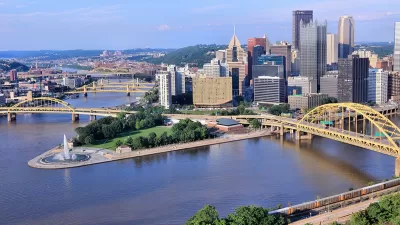From St. Louis to Baltimore, the Rustbelt Cities are seeing a growing population of millennials as a possible cure to shrinking populations and stagnating economies.

The millennial generations, those born starting in 1982, are being seen as potential saviors of the once formidable Rustbelt cities that have fallen on hard economic times as manufacturing and industrial jobs have disappeared. Tim Henderson, writing in Stateline, finds that the growing number of educated millennials moving to cities such as St. Louis, Pittsburgh, Buffalo and Grand Rapids, has given hope for some form of economic rebirth based on a transition to a high-tech, knowledge economy. One of the primary factors attracting this growth can be found in the affordable housing stock available in these cities.
The high cost of living in high-tech centers like Seattle and San Francisco has made them less attractive to many young people, [author Antoine van Agtmael] said. At the same time, affordable housing has helped new hot spots of innovation in Rust Belt cities to emerge.
...
Libby Francis said she came to Baltimore from the District of Columbia looking for urban life at a lower cost in her mid-30s, about 10 years ago.
“I was a single adult chasing the dream of homeownership and I’m not made of money. It was getting pretty depressing,” Francis said. In Hampden she found a house for $110,000 and the financial freedom to open a locally sourced flower shop. “You can actually be an artist here and pay the rent.”
Cities such as Pittsburgh have also invested in amenities that might attract new "fast-growth" businesses, including new public spaces and apartments in the city's downtown.
FULL STORY: Millennials Bring New Life to Some Rust Belt Cities

Study: Maui’s Plan to Convert Vacation Rentals to Long-Term Housing Could Cause Nearly $1 Billion Economic Loss
The plan would reduce visitor accommodation by 25,% resulting in 1,900 jobs lost.

North Texas Transit Leaders Tout Benefits of TOD for Growing Region
At a summit focused on transit-oriented development, policymakers discussed how North Texas’ expanded light rail system can serve as a tool for economic growth.

Why Should We Subsidize Public Transportation?
Many public transit agencies face financial stress due to rising costs, declining fare revenue, and declining subsidies. Transit advocates must provide a strong business case for increasing public transit funding.

How to Make US Trains Faster
Changes to boarding platforms and a switch to electric trains could improve U.S. passenger rail service without the added cost of high-speed rail.

Columbia’s Revitalized ‘Loop’ Is a Hub for Local Entrepreneurs
A focus on small businesses is helping a commercial corridor in Columbia, Missouri thrive.

Invasive Insect Threatens Minnesota’s Ash Forests
The Emerald Ash Borer is a rapidly spreading invasive pest threatening Minnesota’s ash trees, and homeowners are encouraged to plant diverse replacement species, avoid moving ash firewood, and monitor for signs of infestation.
Urban Design for Planners 1: Software Tools
This six-course series explores essential urban design concepts using open source software and equips planners with the tools they need to participate fully in the urban design process.
Planning for Universal Design
Learn the tools for implementing Universal Design in planning regulations.
City of Santa Clarita
Ascent Environmental
Institute for Housing and Urban Development Studies (IHS)
City of Grandview
Harvard GSD Executive Education
Toledo-Lucas County Plan Commissions
Salt Lake City
NYU Wagner Graduate School of Public Service





























